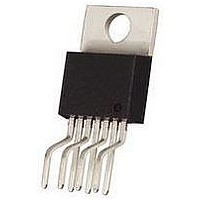LM2678T-3.3 National Semiconductor, LM2678T-3.3 Datasheet - Page 13

LM2678T-3.3
Manufacturer Part Number
LM2678T-3.3
Description
IC, STEP-DOWN REGULATOR, TO-220-7
Manufacturer
National Semiconductor
Datasheet
1.LM2678S-12.pdf
(26 pages)
Specifications of LM2678T-3.3
Primary Input Voltage
12V
No. Of Outputs
1
Output Voltage
3.3V
Output Current
5A
No. Of Pins
7
Operating Temperature Range
-40°C To +125°C
Supply Voltage Range
8V To 40V
Lead Free Status / RoHS Status
Contains lead / RoHS non-compliant
SIMPLE DESIGN PROCEDURE
Using the nomographs and tables in this data sheet (or use
the available design software at http://www.national.com) a
complete step-down regulator can be designed in a few sim-
ple steps.
Step 1: Define the power supply operating conditions:
Required output voltage
Maximum DC input voltage
Maximum output load current
Step 2: Set the output voltage by selecting a fixed output
LM2678 (3.3V, 5V or 12V applications) or determine the re-
quired feedback resistors for use with the adjustable LM2678
−ADJ
Step 3: Determine the inductor required by using one of the
four nomographs, Figure 3 through Figure 6. Table 1 provides
a specific manufacturer and part number for the inductor.
Step 4: Using Table 3 (fixed output voltage) or Table 6 (ad-
justable output voltage), determine the output capacitance
required for stable operation. Table 2 provides the specific
capacitor type from the manufacturer of choice.
Step 5: Determine an input capacitor from Table 4 for fixed
output voltage applications. Use Table 2 to find the specific
capacitor type. For adjustable output circuits select a capac-
itor from Table 2 with a sufficient working voltage (WV) rating
greater than Vin max, and an rms current rating greater than
one-half the maximum load current (2 or more capacitors in
parallel may be required).
Step 6: Select a diode from Table 5. The current rating of the
diode must be greater than I load max and the Reverse Volt-
age rating must be greater than Vin max.
Step 7: Include a 0.01μF/50V capacitor for Cboost in the de-
sign.
FIXED OUTPUT VOLTAGE DESIGN EXAMPLE
A system logic power supply bus of 3.3V is to be generated
from a wall adapter which provides an unregulated DC volt-
age of 13V to 16V. The maximum load current is 4A. Through-
hole components are preferred.
Step 1: Operating conditions are:
Vout = 3.3V
Vin max = 16V
Iload max = 4A
Step 2: Select an LM2678T-3.3. The output voltage will have
a tolerance of
±2% at room temperature and ±3% over the full operating
temperature range.
Step 3: Use the nomograph for the 3.3V device ,Figure 3. The
intersection of the 16V horizontal line (V
vertical line (I
required.
From Table 1, L46 in a through-hole component is available
from Renco with part number RL-1283-15-43.
Step 4: Use Table 3 to determine an output capacitor. With a
3.3V output and a 15μH inductor there are four through-hole
output capacitor solutions with the number of same type ca-
pacitors to be paralleled and an identifying capacitor code
given. Table 2 provides the actual capacitor characteristics.
Any of the following choices will work in the circuit:
2 x 220μF/10V Sanyo OS-CON (code C5)
2 x 820μF/16V Sanyo MV-GX (code C5)
1 x 3900μF/10V Nichicon PL (code C7)
2 x 560μF/35V Panasonic HFQ (code C5)
load
max) indicates that L46, a 15μH inductor, is
in
max) and the 4A
13
Step 5: Use Table 4 to select an input capacitor. With 3.3V
output and 15μH there are three through-hole solutions.
These capacitors provide a sufficient voltage rating and an
rms current rating greater than 2A (1/2 I
Table 2 for specific component characteristics the following
choices are suitable:
2 x 680μF/63V Sanyo MV-GX (code C13)
1 x 1200μF/63V Nichicon PL (code C25)
1 x 1500μF/63V Panasonic HFQ (code C16)
Step 6: From Table 5 a 5A or more Schottky diode must be
selected. For through-hole components only 40V rated
diodes are indicated and 4 part types are suitable:
1N5825
MBR745
80SQ045
6TQ045
Step 7: A 0.01μF capacitor will be used for Cboost.
ADJUSTABLE OUTPUT DESIGN EXAMPLE
In this example it is desired to convert the voltage from a two
battery automotive power supply (voltage range of 20V to
28V, typical in large truck applications) to the 14.8VDC alter-
nator supply typically used to power electronic equipment
from single battery 12V vehicle systems. The load current re-
quired is 3.5A maximum. It is also desired to implement the
power supply with all surface mount components.
Step 1: Operating conditions are:
Vout = 14.8V
Vin max = 28V
Iload max = 3.5A
Step 2: Select an LM2678S-ADJ. To set the output voltage
to 14.9V two resistors need to be chosen (R1 and R2 in Figure
2). For the adjustable device the output voltage is set by the
following relationship:
Where V
A recommended value to use for R1 is 1K. In this example
then R2 is determined to be:
R2 = 11.23KΩ
The closest standard 1% tolerance value to use is 11.3KΩ
This will set the nominal output voltage to 14.88V which is
within 0.5% of the target value.
Step 3: To use the nomograph for the adjustable device, Fig-
ure 6, requires a calculation of the inductor Volt•microsecond
constant (E•T expressed in V•μS) from the following formula:
where V
switch which is R
be typically 0.12Ω x 3.5A or 0.42V and V
across the forward bisased Schottky diode, typically 0.5V.
The switching frequency of 260KHz is the nominal value to
SAT
FB
is the feedback voltage of typically 1.21V.
is the voltage drop across the internal power
ds(ON)
times I
load
. In this example this would
load
D
is the voltage drop
max). Again using
www.national.com














